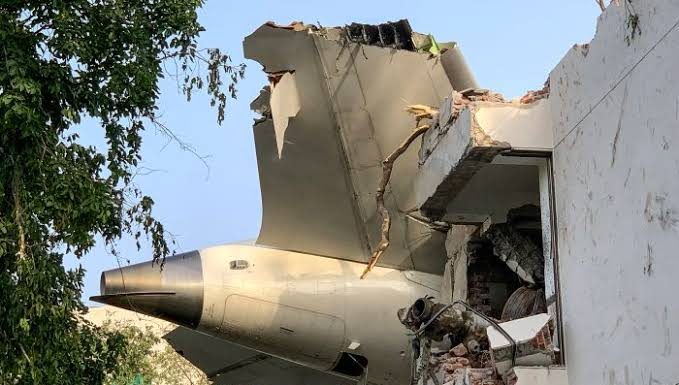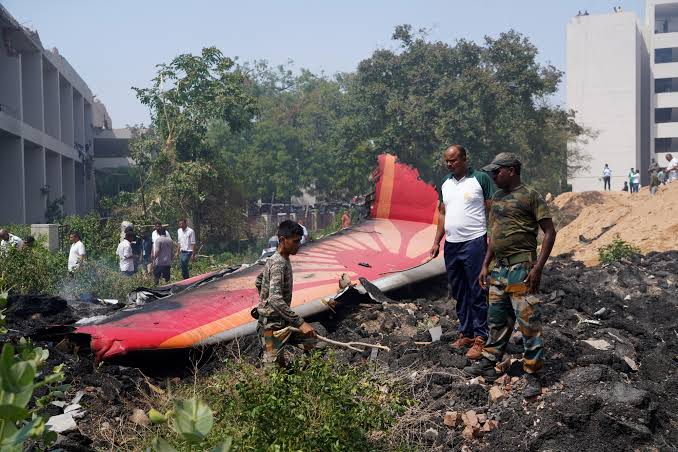On June 12, 2025, Air India Flight AI171, a Boeing 787-8 Dreamliner, crashed moments after takeoff from Ahmedabad’s Sardar Vallabhbhai Patel International Airport, killing 241 of the 242 people on board and at least 28 on the ground. The tragedy, the first fatal crash of a Boeing 787 Dreamliner, shocked the aviation world and sparked intense speculation about its cause. As investigations continue, no definitive root cause has been confirmed, but preliminary findings, expert analyses, and witness accounts point to several potential factors. This article explores the leading theories, the context of the crash, and the ongoing efforts to uncover the truth behind this catastrophic event.
The Crash: A Tragic Sequence of Events
Flight AI171, bound for London Gatwick, departed Ahmedabad at 1:38 p.m. local time, carrying 230 passengers and 12 crew members. According to Flightradar24, the aircraft reached a maximum altitude of 625 feet before issuing a Mayday call, indicating an emergency. Seconds later, communication ceased, and the plane crashed into a medical college hostel in the Meghani Nagar residential area, triggering a massive explosion fueled by approximately 100,000 liters of aviation fuel. The sole survivor, Vishwas Kumar Ramesh, reported hearing a “loud noise” 30 seconds after takeoff, followed by flickering lights and the plane’s rapid descent.
The aircraft, registered as VT-ANB, was an 11-year-old Boeing 787-8 delivered to Air India in January 2014. Piloted by Captain Sumit Sabharwal and co-pilot Clive Kunder, both highly experienced with over 9,000 combined flying hours, the plane appeared to struggle to gain altitude. Video footage showed the aircraft descending with its nose up and landing gear down, an abnormal configuration for takeoff.

Investigating the Root Cause: Key Theories
With one black box recovered and the second located on June 13, 2025, India’s Aircraft Accident Investigation Bureau (AAIB), supported by the US National Transportation Safety Board (NTSB), the UK Air Accidents Investigation Branch, Boeing, and General Electric (the engine manufacturer), is leading the probe. While a conclusive report may take months or years, several theories have emerged based on initial evidence, expert insights, and posts on X.
1. Engine Failure or Loss of Thrust
One of the most prominent theories suggests a catastrophic loss of engine power. The Boeing 787-8 is powered by two General Electric GEnx engines, and some speculate that both engines may have failed simultaneously, leaving the aircraft without sufficient thrust to climb. A post on X claimed that “both engine compressors stalled,” resulting in a 240-tonne aircraft unable to generate lift.
Aviation experts note that dual engine failure is rare but possible, with potential causes including:
- Bird Strike: Dr. Jason Knight from the University of Portsmouth suggested that a bird strike could have caused both engines to fail, given the low altitude and proximity to the airport. Bird strikes are a known hazard during takeoff, and Ahmedabad’s urban environment may increase such risks.
- Fuel Contamination or Delivery Issues: Contaminated fuel or a failure in the fuel delivery system could have starved the engines, though this would require significant maintenance or supply chain lapses.
- Mechanical Failure: Engine corrosion or component failure, as seen in past 787 incidents with Rolls-Royce engines, could have played a role, though GE engines have a different track record.
The loud noise reported by the survivor could indicate an engine-related issue, such as a compressor stall or explosion. However, the 787 is designed to fly on one engine, so a dual failure would point to an extraordinary event.
2. Flap Configuration Error
Another theory focuses on the aircraft’s wing flaps, which are critical for generating lift during takeoff. Video analysis by aviation experts, including former British Airways pilot Alastair Rosenschein, suggested that the flaps may not have been extended properly. Incorrect flap settings could prevent the plane from climbing, especially with a full fuel load.
The 787’s Takeoff Configuration Warning System (TOCWS) is designed to alert pilots to improper flap settings, but a post on X noted that pilots could theoretically ignore these warnings, though this would be highly unusual given the experienced crew and multiple pre-takeoff checklists. Former pilot Mr. Chan told BBC Verify that flap errors are “highly unusual” due to rigorous procedures.
If flaps were retracted or misconfigured, the aircraft would require a longer runway to gain speed, consistent with reports that Flight AI171 used the full 11,499-foot Runway 23. The plane’s shallow climb and dust at the runway’s end, as noted by former United Airlines captain Laura Savino, support this theory.
3. Human Error and Automation Dependency
Some aviation professionals, including a former jet pilot on X, have suggested that human error, possibly compounded by over-reliance on automation, could be a factor. The pilot, claiming 6,000 hours of experience, described the crash as a “textbook breakdown of automation dependency, flawed data inputs, and eroded stick-and-rudder basic airmanship.”
This theory posits that incorrect data entry, such as weight or performance calculations, could have led to improper thrust or flap settings. Former Air Force accident investigator David Scholl, cited in a post on X, also pointed to possible “incorrect data entry” or “flap setting error” as potential causes.
However, Captain Sabharwal’s 22 years of experience and the crew’s adherence to checklists make gross human error less likely, though not impossible. The 787’s advanced automation systems, while reducing pilot workload, have been criticized in past incidents (e.g., Boeing 737 MAX crashes) for creating dependency or confusion under stress.
4. Structural or Manufacturing Defects
The crash has reignited concerns about Boeing’s manufacturing quality, particularly after whistleblower allegations in 2024. Boeing engineer Sam Salehpour testified to Congress that the 787’s fuselage had “thousands of gaps” due to improper fastening, potentially reducing the aircraft’s lifespan. Another whistleblower, John Barnett, alleged in 2019 that faulty parts were used on 787s, though Boeing denied these claims.
Between 2021 and 2023, 787 deliveries were halted due to assembly defects, including fuselage gaps and improperly fastened components. While the aircraft involved (VT-ANB) was delivered in 2014, long-term structural stress could theoretically contribute to a failure. However, no evidence currently links these issues directly to the crash, and Boeing has stated there is “no indication” of a manufacturing fault.
5. Maintenance Issues
Air India’s maintenance practices have come under scrutiny, with a post on X alleging that a “maintenance issue” caused the engine compressors to stall. India’s Directorate General of Civil Aviation (DGCA) reportedly warned Air India about safety lapses in the past, and the airline’s 2020 Kozhikode crash raised questions about its safety culture.
The 787 involved had 41,000 flight hours, considered average, but maintenance records are being examined for missed inspections or deferred repairs. Air India grounded its entire 787 fleet pending the investigation, suggesting concerns about systemic issues.
6. External Factors
Less likely but not ruled out are external factors like sabotage or weather. A post on X by a user claiming National Security Guards (NSG) recovered the black box stated that sabotage was “apparently” not involved, though this remains unverified. Weather conditions in Ahmedabad on June 12 were not reported as severe, making factors like wind shear unlikely.
The Investigation: Challenges and Next Steps
The recovery of one black box and the location of the second are critical milestones. The 787’s flight data recorder, which monitors thousands of parameters, and the cockpit voice recorder will provide insights into the aircraft’s systems, pilot actions, and final moments. However, the intense fire and explosion may have damaged the boxes, complicating data retrieval.
Investigators face additional challenges:
- Ground Casualties: The crash site’s residential location and the destruction of a medical college hostel make it difficult to distinguish between aircraft and ground victims, delaying identification and analysis.
- Public Pressure: With 241 fatalities, including 53 British nationals, and global attention on Boeing, there is intense pressure for quick answers, risking premature conclusions.
- Complex Systems: The 787’s advanced composite structure and automation systems require specialized expertise to analyze, prolonging the investigation.
The AAIB’s final report will likely identify a chain of events rather than a single cause, as modern aviation accidents often involve multiple failures. For example, the 2018 and 2019 Boeing 737 MAX crashes revealed a combination of design flaws, pilot training issues, and regulatory oversights.
Implications for Boeing, Air India, and Indian Aviation
The crash has profound consequences:
- Boeing: The Dreamliner’s flawless safety record is shattered, and Boeing’s stock fell over 8% post-crash. Renewed scrutiny of manufacturing practices and whistleblower allegations could lead to further FAA inspections or delivery delays.
- Air India: The airline, under Tata Group’s revival efforts, faces a crisis of confidence. Grounding its 787 fleet disrupts long-haul operations, and past safety concerns amplify calls for stricter oversight.
- Indian Aviation: As India aims to become a global aviation hub, the crash highlights gaps in regulatory enforcement and infrastructure. The DGCA’s role in monitoring Air India and airport safety is under review.
Current Sentiment and Speculation
Posts on X reflect a mix of grief, anger, and speculation. Some users blame Boeing’s quality control, citing whistleblower warnings, while others point to Air India’s maintenance or pilot error. Unverified claims, such as dual engine failure or automation issues, fuel public debate, but experts urge caution until the investigation concludes.
Conclusion: A Complex Puzzle
As of June 13, 2025, the root cause of the Boeing 787 crash in Ahmedabad remains unknown. Leading theories include dual engine failure, flap configuration errors, human error, manufacturing defects, or maintenance lapses, but no single factor has been confirmed. The investigation, bolstered by black box data and international expertise, will aim to unravel the sequence of events that led to this tragedy.
For now, the focus remains on supporting victims’ families and preventing future disasters. The crash of Flight AI171 is a sobering reminder of the complexities of modern aviation and the need for rigorous safety standards across manufacturers, airlines, and regulators. As the world awaits answers, the lessons from this tragedy will shape the future of the Boeing 787, Air India, and global air travel.













